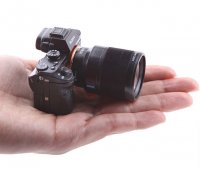"......No one has fed the troll, good job guys. It was interesting to see him POST again.

....."
---
It's been a while....been away on "Important Business".
I actually DO KNOW MUCH MORE what's coming down the pipeline than you do and THAT IS AN ABSOLUTE FACT!
and THAT FACT has been used by me for the last few months now and it is SWEEEEEEEEEEET !!!!!!!!!!!!!!!!!!!!!!!!
Your comments are what they are and only a photo/video of what's sitting on my desk can change that AND you ain't gettin' it,
although, you CAN take a look at SOME of it's output as per the photos in my posting but other than that you'll have to wait.......
AND.....in case you're wonder HOW the photos were made to look that good on DCT JPEG, the key is using smaller block sizes and specially made human eye-centric quantization tables than the normal JPEG quantization tables which does give a slight rise in photo size BUT really makes a visual difference.
AND YES I was the one who designed them! That human-eye-centricity towards compression is also applied to my 16-bits per channel Wavelet/JPEG-2000 frequency-based quantization parameters which is why A BIG GIANT MEDIA COMPANY is gonna finally give you what you want in a large sensor COMBINED stills and video camera!


